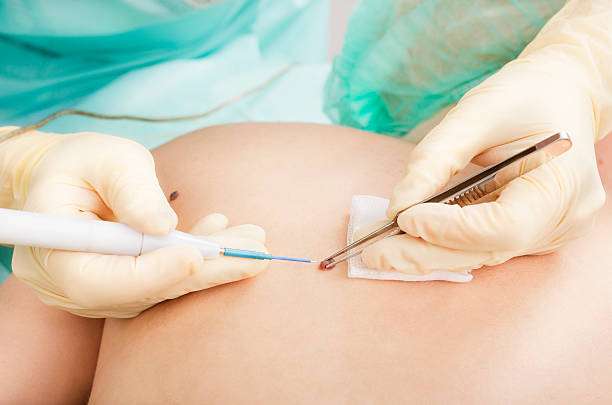Here some quick information you could need about Mole Treatment:
| The Cost | Start at 100 EUR, Depends on each case & the used technique |
| Session Number | 1 Session (with a revision session, sometimes) |
| Before Session | Avoid using creams / cosmetics on the areas to be treated |
| Session duration | 15-45 minutes |
| After Session | Avoid hot water, direct sun light, cleansing the wound |
| Results | Start to appear after one week |
Mole Treatment is a medical technique that eliminates a mole from your skin. There are various reasons why someone may decide to get a mole removed:
- Cosmesis: Removing a mole that is big, itchy, or otherwise uncomfortable can improve both look and comfort.
- Skin cancer concern: If a doctor feels a mole is malignant (melanoma), they will urge removal for biopsy, which involves examining the tissue under a microscope to confirm or rule out malignancy.
Mole Treatment Options
There are four major types of Mole Treatment, each suited to a distinct situation:
Excision is a small surgical technique in which a dermatologist (skin doctor) numbs the region before removing the mole and stitching the incision together. This is the most popular approach, particularly for possibly malignant moles, because it allows for thorough removal and evaluation of the tissue.
Shave removal is similar to excision, except that the practitioner uses a surgical blade to shave the mole off level with the skin. Stitches may not be necessary. This is faster than excision, however it may leave a scar and is less likely to remove the entire mole, making it unsuitable for worrisome moles.
Laser removal: A focused beam of light vaporizes the mole tissue. This is commonly used to treat tiny, superficial moles on cosmetically sensitive locations such as the face. It may take several sessions and is not appropriate for biopsies.
Cryotherapy (freezing) uses liquid nitrogen to freeze and kill mole tissue. This is an excellent choice for tiny, non-cancerous moles, although it may result in a lighter area of skin and is not always successful for total elimination.
What to Expect During Mole Treatment
Before the procedure:
- Consultation: You and your doctor will discuss the mole, including your reasons for excision and medical history. They will evaluate the mole to decide the best removal strategy.
- Local anesthetic will be administered around the mole to numb it. You may feel a little prick from the needle.
- Preparation: Clean the area surrounding the mole with an antiseptic solution.
The operation normally takes 10-30 minutes, however this might vary depending on the intricacy. You should not experience any discomfort during the removal.
Following the procedure:
- The doctor will apply a bandage to the affected region.
- Discomfort: After the numbness wears off, you may feel minor stinging or burning. Over-the-counter pain medications can help alleviate discomfort.
- Stitches: If stitches were used, they are likely to be removed within 7-10 days.
Biopsy findings: If the mole was removed for biopsy, you should receive the results within a few days or a week.
Recovery After Mole Treatment

Recovering following Mole Treatment is a reasonable procedure that typically takes 1 week for the wound to fully heal. Here’s what to anticipate throughout this time:
Wound Care:
- Keep things clean. Wash the area carefully with soap and water, following your doctor’s particular recommendations for frequency and drying procedure.
- Moisturize: Use petroleum jelly or another ointment prescribed by your doctor to keep the wound moist and promote healing.
- Bandaging: Depending on the manner of removal and your doctor’s recommendation, you may need to keep the area wrapped for 24-48 hours, or until the wound heals.
- Do not choose! Avoid picking at the scab or sutures (if used). Picking can impair healing and raise the risk of scars.
General aftercare:
- Minimize discomfort. Over-the-counter pain medicines such as ibuprofen can assist with any soreness.
- Sun protection: Once the incision has healed and the scabbing has subsided, it is critical to shield the region from sun exposure. Apply sunscreen with an SPF of 30 or higher anytime the region is exposed. Sun exposure can exacerbate scarring.
- Strenuous activity should be avoided, especially in the first few days, since it may aggravate the incision.
- Listen to your body: If you have extreme pain, redness, swelling, or pus leakage from the incision, call your doctor right away since these might be indicators of infection.
Can Moles Come Back After Removal?
Moles may return after being removed, but this is uncommon. Here’s why:
- Incomplete removal: The most common cause for a mole to recur is that some mole cells remained in the skin during the original surgery. This can happen for a number of reasons, including inadequate depth or length of therapy.
- Mole Treatment method: Some removal procedures, such as shaving or cryotherapy, are less likely to remove the entire mole than surgical excision, which eliminates the mole while leaving a margin of healthy tissue.
However, it is vital to remember that:
- Regrowth is not cancer: Just because a mole reappears does not always indicate it is carcinogenic. Both malignant and non-cancerous moles have the same likelihood of renewal.
- Visit a doctor: If you see a mole reappear after removal, see your doctor for an evaluation. They can tell if it’s a simple regrowth or something more serious.
To reduce the risk of regrowth, it is vital to:
Select a skilled dermatologist. An skilled dermatologist will select the best removal strategy for your unique mole.
Complete removal: Surgical excision is the most successful procedure for completely removing the mole and surrounding tissue.
If you have any concerns regarding Mole Treatment or a mole that has resurfaced, you can reach us through this link , for our social media here our Instagram link. to read more here another link



